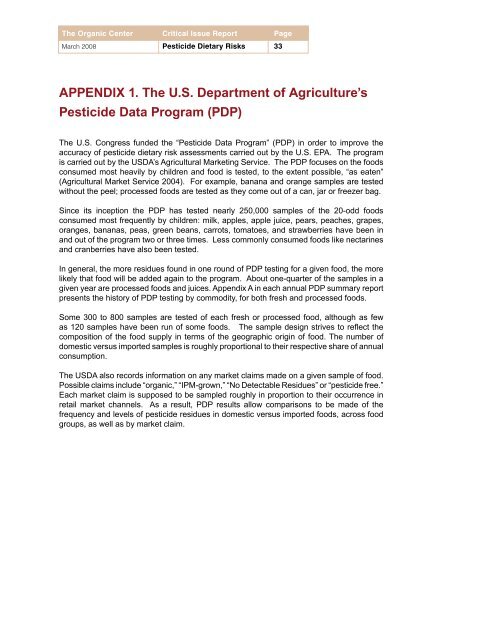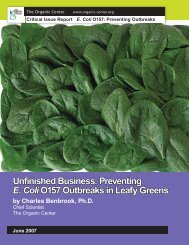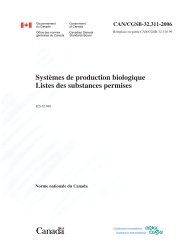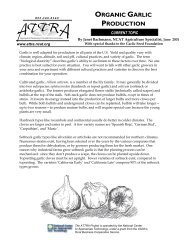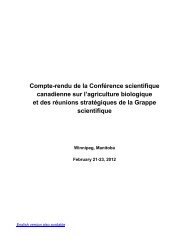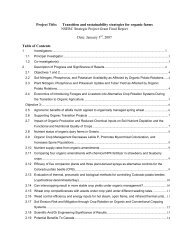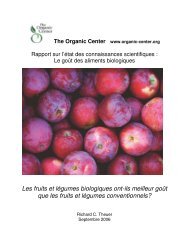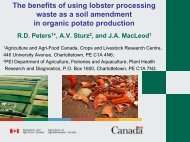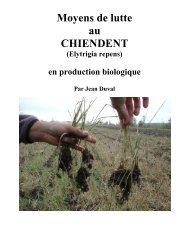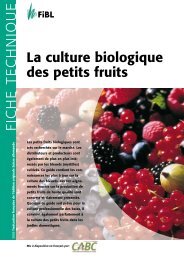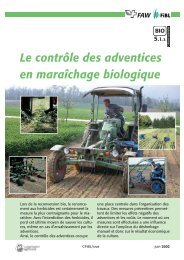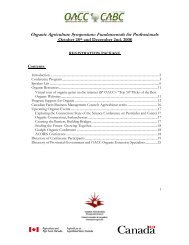The Organic Option - Centre d'agriculture biologique du Canada
The Organic Option - Centre d'agriculture biologique du Canada
The Organic Option - Centre d'agriculture biologique du Canada
Create successful ePaper yourself
Turn your PDF publications into a flip-book with our unique Google optimized e-Paper software.
<strong>The</strong> <strong>Organic</strong> Center Critical Issue Report Page<br />
March 2008 Pesticide Dietary Risks 33<br />
APPENDIX 1. <strong>The</strong> U.S. Department of Agriculture’s<br />
Pesticide Data Program (PDP)<br />
<strong>The</strong> U.S. Congress funded the “Pesticide Data Program” (PDP) in order to improve the<br />
accuracy of pesticide dietary risk assessments carried out by the U.S. EPA. <strong>The</strong> program<br />
is carried out by the USDA’s Agricultural Marketing Service. <strong>The</strong> PDP focuses on the foods<br />
consumed most heavily by children and food is tested, to the extent possible, “as eaten”<br />
(Agricultural Market Service 2004). For example, banana and orange samples are tested<br />
without the peel; processed foods are tested as they come out of a can, jar or freezer bag.<br />
Since its inception the PDP has tested nearly 250,000 samples of the 20-odd foods<br />
consumed most frequently by children: milk, apples, apple juice, pears, peaches, grapes,<br />
oranges, bananas, peas, green beans, carrots, tomatoes, and strawberries have been in<br />
and out of the program two or three times. Less commonly consumed foods like nectarines<br />
and cranberries have also been tested.<br />
In general, the more resi<strong>du</strong>es found in one round of PDP testing for a given food, the more<br />
likely that food will be added again to the program. About one-quarter of the samples in a<br />
given year are processed foods and juices. Appendix A in each annual PDP summary report<br />
presents the history of PDP testing by commodity, for both fresh and processed foods.<br />
Some 300 to 800 samples are tested of each fresh or processed food, although as few<br />
as 120 samples have been run of some foods. <strong>The</strong> sample design strives to reflect the<br />
composition of the food supply in terms of the geographic origin of food. <strong>The</strong> number of<br />
domestic versus imported samples is roughly proportional to their respective share of annual<br />
consumption.<br />
<strong>The</strong> USDA also records information on any market claims made on a given sample of food.<br />
Possible claims include “organic,” “IPM-grown,” “No Detectable Resi<strong>du</strong>es” or “pesticide free.”<br />
Each market claim is supposed to be sampled roughly in proportion to their occurrence in<br />
retail market channels. As a result, PDP results allow comparisons to be made of the<br />
frequency and levels of pesticide resi<strong>du</strong>es in domestic versus imported foods, across food<br />
groups, as well as by market claim.


